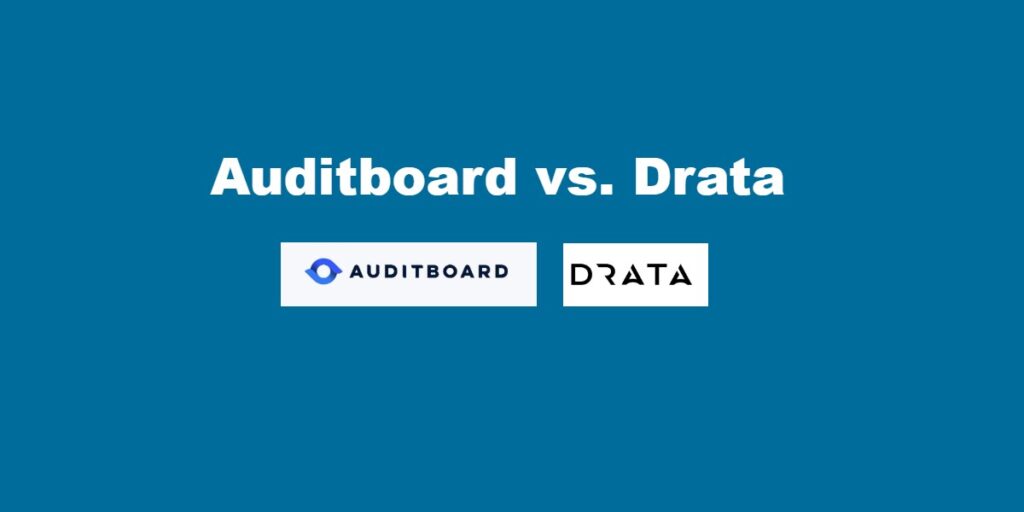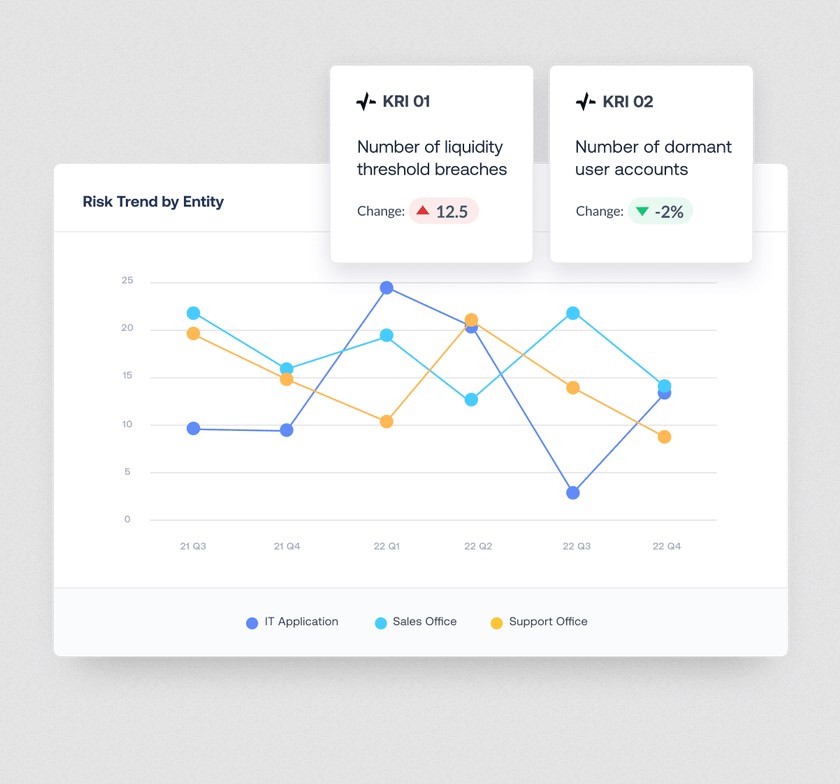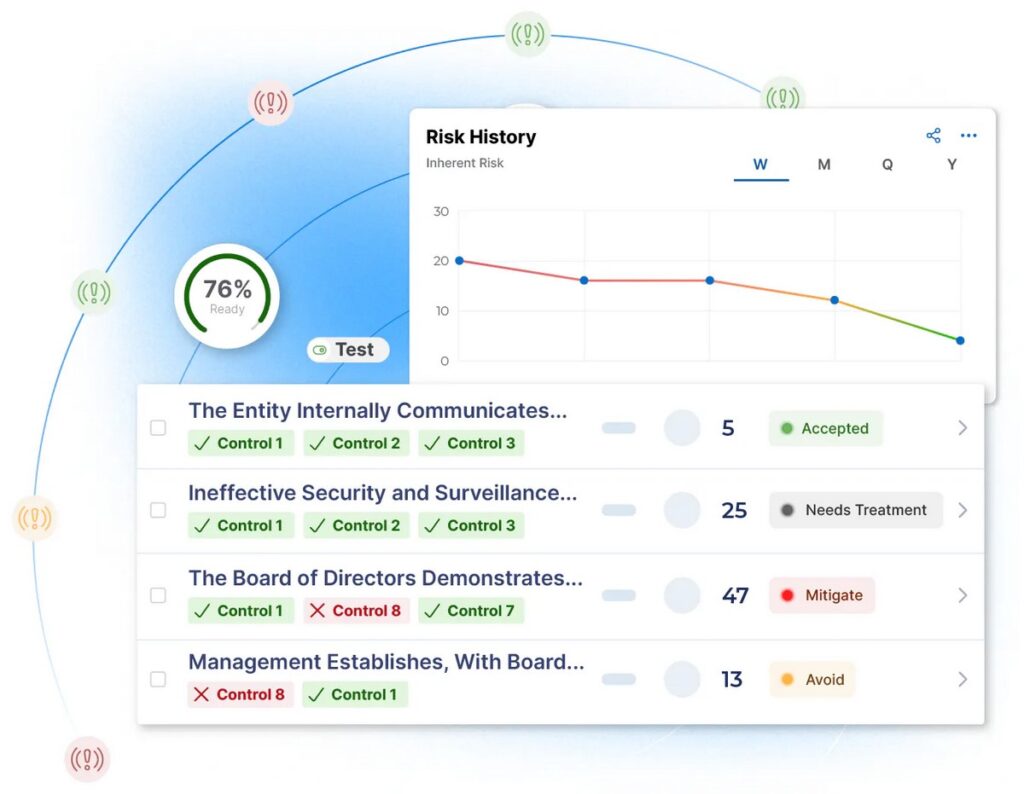Governance, Risk, and Compliance (GRC) has become a mainstream operation of organizations today because of its growing role in effectively managing risks, reducing the associated costs, and meeting compliance requirements. At the same time, managing GRC is complex because it involves many processes, workflows, and tasks. Moreover, the growing list of compliance requirements necessitates more resources, making it difficult for organizations to leverage the benefits of GRC programs.
One way to address this challenge is to use GRC software platforms that automate many associated tasks and processes, thereby reducing non-compliance risks and optimizing your existing resources. However, choosing the right platform is key to ensuring you get the most out of your GRC programs.
In this guide, we review two well-known players in the GRC space – AuditBoard and Drata. Read on to know what these two tools offer and which is right for you.
AuditBoard Highlights
AuditBoard is an audit, compliance, and risk management software that prepares your organization to meet known and unknown risks while ensuring compliance with the established standards. This collaborative and intelligent risk management platform helps navigate the dynamic risk environment and in the process, enhance your business outcomes.
Source: AuditBoard
Below are AuditBoard’s notable features.
Streamlined Risk Management
AuditBoard can identify and assess risks that impact your organization. It standardizes risks and creates a common language that enables everyone in the organization to understand them. Such a common approach boosts collaboration and increases the effectiveness of risk mitigation strategies.
Internal Control Management
You can use AuditBoard to handle SOX and other internal control compliance, as it automates administrative tasks and reporting. Moreover, it also simplifies documentation by syncing updates to controls as they happen. Furthermore, it keeps your documents up-to-date and uses logs to track the changes. All this information is displayed on reports and dashboards in real time to provide insights into your internal control programs.
Automated Workflows
AuditBoard makes it easy to comply with multiple compliance programs. This intuitive and scalable platform creates a dynamic multi-frame environment and optimizes key common tasks through automated workflows. As a result, you can meet the requirements of multiple programs simultaneously. More importantly, its out-of-the-box reporting templates provide the C-suite with all the information they need for data-driven decision-making.
Extensive Integrations
Another prominent aspect of AuditBoard is its extensive integrations. You can use them to connect to different parts of your ecosystem and automate your audit, risk, and ESG programs. Due to these integrations, you can create seamless data flow within your organization, and gain better insights into your compliance.
AI and Analytics
AuditBoard leverages AI to analyze your existing data and provide meaningful and contextual insights. Also, it recommends appropriate actions after analyzing multiple data points, easing your time and effort. Its automated workflows can even implement some of these recommendations for you. All this means you can use your resources optimally and focus on the high-impact areas.
Overall, AuditBoard is a comprehensive platform that handles every aspect of your GRC with clarity and precision, making it a great addition to your risk and compliance processes.
Pros:
- Internal control documentation.
- Maintains audit trails.
- Risk identification, assessment, and mitigation.
- Well-designed dashboards and reports.
Cons:
- Customer support can be better.
- Large data volumes can impact performance.
Key Highlights
- Real-time risk assessments.
- Streamlines audits with real-time documents and logs.
- 200+ integrations.
- Detailed analysis and contextual insights.
- Out-of-the-box reports.
- Automated workflows to save time and effort.
Drata Key Highlights
Drata is an automated compliance management tool that works best for security-related frameworks like HIPAA, GDPR, SOC 2, and more. It comes with comprehensive features to automate your entire compliance lifecycle. As a result, Drata works well for all organizations, from startups to established enterprises that want to streamline compliance.
Source: Drata
Let’s now look at Drata’s features.
Adaptive Automation
Every organization has a different compliance journey, and this is why one-size-fits-all programs fail. Drata introduces a feature called adaptive automation, where you can configure compliance to meet your specific needs. Also, its integration with extended testing sources makes it easy to build no-code tests with custom logic to automate your compliance. At the same time, you can also have total control over your compliance monitoring.
Automated Evidence Collection
Drata automates evidence collection, reducing the associated manual effort. You can use Drata’s APIs, custom tests, and integrations to collect evidence when needed from different sources. This process reduces the need to track and manage evidence in a spreadsheet.
Integrations
With 140+ integrations, Drata can fit well into any tech stack. Moreover, it offers open API access for integration with custom apps. With such extensive options, Drata can handle deep automation and workflows that provide more reliable insights into your security and compliance patterns. Armed with this information, you can make appropriate decisions to improve your business outcomes.
Continuous Control Monitoring
Drata continuously monitors your controls and ensures they align with the compliance requirements. It comes with many preconfigured templates that can easily identify compliance gaps. In case of non-compliance, it quickly creates tickets and tracks their progress to ensure that your compliance programs don’t collapse. Moreover, you can use role-based access to assign these tickets while streamlining access to sensitive data.
With such extensive features, Drata helps you stay on top of your security and compliance. Its report-generation capabilities also help you make informed decisions.
Pros:
- Offers customized compliance management.
- Intuitive user interface.
- Excellent customer support.
- Preconfigured templates to identify gaps.
Cons:
- Limited integrations.
- Expensive, especially for startups and small businesses.
Key Highlights
- Automates compliance with standards like SOC 2, ISO 27001, GDPR, PCI DSS, and HIPAA.
- Supports the entire compliance journey.
- Works well for organizations that are currently at different stages of compliance.
- Adaptive automation helps create programs that are unique to each organization.
- Focus on security along with compliance.
- Automates evidence collection.
- Identifies and fixes compliance gaps.
- Provides open API access to integrate with custom applications.
AuditBoard vs. Drata – A Head-to-head Comparison
AuditBoard and Drata are popular choices for GRC programs because of the many common features they share. In particular, their automated workflows and intuitive dashboards are a big draw for customers.
Here’s a look at the other common features that are well-appreciated by customers.
Common Features
Below are the common features shared by both platforms:
- Audit and compliance.
- Extensive alerts and notifications.
- Controls testing.
- Workflow automation.
- Operational risk and policy management.
Now that we have seen the common features, let’s move on to the differences.
Differences Between AuditBoard and Drata
Though AuditBoard and Drata share common features and help organizations with the GRC programs, they also have many differences. Let’s look at the important ones.
Focus Areas
AuditBoard is a comprehensive GRC platform focusing on audit management and compliance, while Drata is known for its security and compliance capabilities. When you compare the two, AuditBoard is highly customizable, making it ideal for organizations of all sizes and needs. Drata, on the other hand, is more focused on security and meeting the compliance requirements associated with it like SOC 2 and ISO 27001, making it ideal for organizations that require a continuous cybersecurity-based GRC program.
Cloud Offerings
Drata is well-suited for cloud security and compliance, as it supports continuous monitoring, encrypts sensitive data, uses least-privileged access policies, and helps meet the required cybersecurity requirements to keep your data safe in the cloud. It also ensures that your cloud apps have the necessary cybersecurity protection by checking them against established best practices. Also, Drata natively supports 14+ regulatory frameworks and standards. Moreover, it can be customized for other cloud compliance standards.
AuditBoard, on the other hand, is a cloud-based platform that is more suited for regulatory change management and risk compliance, regardless of whether your app and data are on-premises or in the cloud. In this sense, AuditBoard has a wider scope, but may not have cloud-specific cybersecurity features.
Integration
Another area where the two platforms differ is in their integration capabilities. AuditBoard integrates well with most leading platforms today to provide cohesive workflows and solutions. Though Drata also integrates well with many tools, they are largely limited to cybersecurity assessments and audit platforms.
Other Differences
Besides the above major differences, AuditBoard and Drata also have minor variations like the ones below.
- Drata is compatible with macOS, while AuditBoard is suited for Windows desktop and web app platforms.
- Drata offers customer support through email, phone, live support, ticket management, and training while AuditBoard’s customer support is primarily through email.
- AuditBoard offers features like issue and forms management, archiving, incident management, surveys and feedback, risk management, disaster recovery, and more.
Thus, these are differences between AuditBoard and Drata.
Final Verdict
Which of the two is better?
AuditBoard is more comprehensive and can cover a wider range of GRC, including risk management, disaster recovery, and environmental compliance. Drata, on the other hand, is laser-focused on cybersecurity on the cloud and on-premises and ensures that your organization meets all the related security frameworks and regulations.
While both platforms are good, go for Drata if the primary focus of your GRC is cybersecurity. But, if you want a more comprehensive program that scales well with your future expansion plans, go for AuditBoard.


